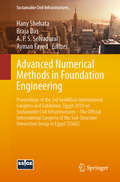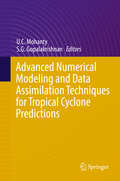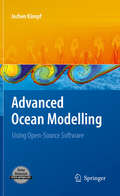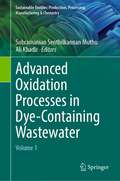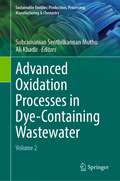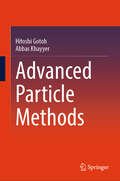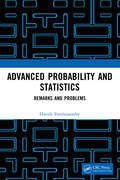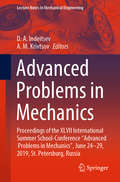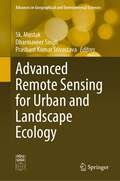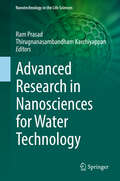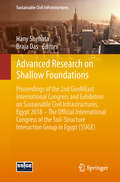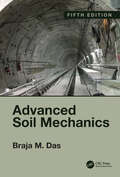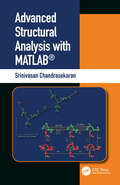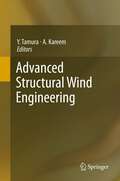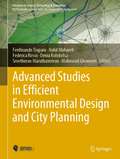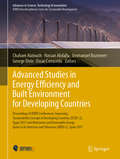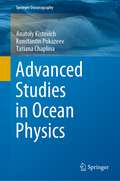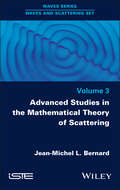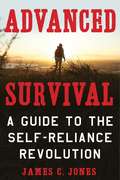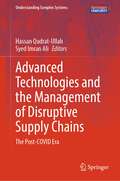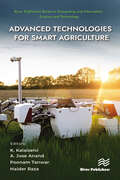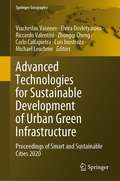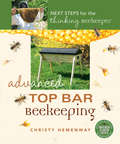- Table View
- List View
Advanced Numerical Methods in Foundation Engineering: Proceedings of the 3rd GeoMEast International Congress and Exhibition, Egypt 2019 on Sustainable Civil Infrastructures – The Official International Congress of the Soil-Structure Interaction Group in Egypt (SSIGE) (Sustainable Civil Infrastructures)
by Hany Shehata Braja Das A. P. S. Selvadurai Ayman FayedThis book deals with the advanced analysis of the shallow foundations. Several research studies are considered including soil plasticity, cracking, reaching the soil bearing capacity, and creep. Dynamic analyses together with stability analysis are also included. It gives a wide range of dealing with the shallow foundations in different parts of the world.
Advanced Numerical Modeling and Data Assimilation Techniques for Tropical Cyclone Prediction
by U. C. Mohanty Sundararaman G. GopalakrishnanThis book deals primarily with monitoring, prediction and understanding of Tropical Cyclones (TCs). It was envisioned to serve as a teaching and reference resource at universities and academic institutions for researchers and post-graduate students. It has been designed to provide a broad outlook on recent advances in observations, assimilation and modeling of TCs with detailed and advanced information on genesis, intensification, movement and storm surge prediction. Specifically, it focuses on (i) state-of-the-art observations for advancing TC research, (ii) advances in numerical weather prediction for TCs, (iii) advanced assimilation and vortex initialization techniques, (iv) ocean coupling, (v) current capabilities to predict TCs, and (vi) advanced research in physical and dynamical processes in TCs. The chapters in the book are authored by leading international experts from academic, research and operational environments. The book is also expected to stimulate critical thinking for cyclone forecasters and researchers, managers, policy makers, and graduate and post-graduate students to carry out future research in the field of TCs.
Advanced Ocean Modelling: Using Open-Source Software
by Jochen KämpfThis book introduces the reader to advanced methods used in the computer-based modelling of fluid processes. This includes nonhydrostatic processes such as breaking internal waves and density-driven convection, but the model code is also used to simulate an El-Niño event! The book contains 25 practical exercises, using freely available Open-Source software suites, which are widely used by the scientific community. In this book, the art of hydrodynamic modelling is made available and transparent to a wider readership. An attractive byproduct of the book is that results are animations rather than still images. Model codes and animation scripts for all exercises are supplied on a website. The reader can adopt model codes for own independent studies
Advanced Oxidation Processes in Dye-Containing Wastewater: Volume 1 (Sustainable Textiles: Production, Processing, Manufacturing & Chemistry)
by Subramanian Senthilkannan Muthu Ali KhadirAmong various industries releasing wastewater into the environment, printing, dyeing and textile industries are of great importance as they frequently contain high amounts of colorful compounds having high chemical and biological oxygen demands. Health related effects of colorants are extensively reported; which necessitates the seriousness of dye removal from water and wastewater. The utilization of advanced oxidation processes (AOPs) in dye degradation has gained considerable attention recently due to the release of high energetic radicals as oxidants that are capable of removing dye compounds. This Volume 1 presents versatile applications of AOPs in dye removal. Accordingly, processes such as Ozone-based AOPs, UV irradiation, catalytic AOPs, etc are discussed with the aim of dye removal under different operational parameters. The role of different nanoparticles is also investigated. By presenting the fundamentals of AOPs as well as recent advances, this book is useful for environmental engineers and chemists who are concerned with wastewater pollution and treatment.
Advanced Oxidation Processes in Dye-Containing Wastewater: Volume 2 (Sustainable Textiles: Production, Processing, Manufacturing & Chemistry)
by Subramanian Senthilkannan Muthu Ali KhadirTextile industry wastewater contains toxic dyes as well as heavy metals and many other persistent organic compounds which are difficult to biodegrade using conventional biological methods. Advanced Oxidation Processes (AOPs) are one of the best alternatives for the effective degradation of such compounds. This Volume 2 starts with homogeneous and heterogeneous Fenton processes and reviews the application and variables that affect the process. It then discusses plasma technology- an emerging method in terms of its chemistry, treatment set-up, limitations, etc. The positive performance of carbon tetrachloride in process intensification of dye degradation is presented. The other chapters include topics such as sonoenzymatic treatment processes, electroflocculation versus textile wastewater, combination of photocatalysis and membrane Separation, and enhancement of anaerobic digestion and photodegradation through adsorption.
Advanced Particle Methods
by Hitoshi Gotoh Abbas KhayyerThis book provides an in-depth, comprehensive, and comprehensible description of the theoretical background and numerical methodologies corresponding to advanced particle methods formulated in classical Newtonian mechanics for simulation of fluids, structures, and their interactions. Particle methods are regarded as new-generation computational technology with a broad range of applications in engineering and science. Advanced particle methods refer to the latest developed particle methods with high stability, accuracy, conservation, and convergence properties. Distinctively, the described advanced particle methods are characterized by a clear, consistent mathematical–physical background, the absence of artificial numerical stabilizers that often require parameter tuning, rigorous satisfaction of boundary conditions, and excellent numerical results that have been extensively and scrupulously verified with respect to reliable analytical and experimental reference solutions. This book presents a unified description for both smoothed particle hydrodynamics (SPH) and moving particle semi-implicit (MPS) methods through a coherent presentation of fundamental equations, and numerical algorithms and schemes. Special attention is devoted to meticulous and coherent explanation of the advanced particle methods such that even undergraduate students can follow the derivation process and thoroughly understand the concepts and equations. The state-of-the-art particle method technology is also portrayed with the presentation of developed multi-physics, multi-scale particle methods corresponding to multi-phase flows, and hydroelastic fluid–structure interactions with rigorous treatment of interfacial moving boundaries.
Advanced Probability and Statistics: Remarks and Problems
by Harish ParthasarathyThe chapters in this book deal with: Basic formulation of waveguide cavity resonator equations especially when the cross sections of the guides and resonators have arbitrary shapes. The focus is on expressing the total field energy within such a cavity resonator as a quadratic form in the complex coefficients that determine the modal expansions of the electromagnetic field. The reviews of basic statistical signal processing covering linear models, fast algorithms for estimating the parameters in such linear models, applications of group representation theory to image processing problems especially the representations of the permutation groups and induced representation theory applied to image processing problems involving the three dimensional Euclidean motion group. The Hartree-Fock equations for approximately solving the two electron atomic problem taking spin-orbit magnetic field interactions into account has been discussed. In the limit as the lattice tends to a continuum, the convergence of the stochastic differential equations governing interacting particles on the lattice to a hydrodynamic scaling limit. It will be useful to undergraduate and postgraduate students with courses on transmission lines and waveguides, and statistical signal processing. Print edition not for sale in South Asia (India, Sri Lanka, Nepal, Bangladesh, Pakistan or Bhutan).
Advanced Problems in Mechanics: Proceedings of the XLVII International Summer School-Conference “Advanced Problems in Mechanics”, June 24-29, 2019, St. Petersburg, Russia (Lecture Notes in Mechanical Engineering)
by D. A. Indeitsev A. M. KrivtsovThis book focuses on original theories and approaches in the field of mechanics. It reports on both theoretical and applied research, with a special emphasis on problems and solutions at the interfaces of mechanics and other research areas. The respective chapters highlight cutting-edge works fostering development in fields such as micro- and nanomechanics, material science, physics of solid states, molecular physics, astrophysics, and many others. Special attention has been given to outstanding research conducted by young scientists from all over the world. Based on the 47th edition of the international conference “Advanced Problems in Mechanics”, held on June 24–29, 2019, in St. Petersburg, Russia, and organized by Peter the Great St. Petersburg Polytechnic University and Institute for Problems in Mechanical Engineering of Russian Academy of Sciences under the patronage of Russian Academy of Sciences, the book provides researchers and graduate students with an extensive overview of the latest research and a source of inspiration for future developments in various fields of mechanics.
Advanced Remote Sensing Technology for Covid-19 Monitoring and Forecasting
by Maged MarghanyThis book provides a groundbreaking exploration of satellite remote sensing's role in tracking the mobility and spread of COVID-19, focusing on its origin in Wuhan City. It addresses the gap in research by employing advanced techniques like quantum image processing to analyze satellite data and differentiate between COVID-19-related deaths and other causes. Additionally, it explores conspiracy theories, vaccine development through quantum mechanics, and the use of quantum computing for detecting pandemic patterns. The book also delves into the economic impact of COVID-19, offering a scientific response to geopolitical tensions and media accusations surrounding the pandemic's origins.
Advanced Remote Sensing Technology for Tsunami Modelling and Forecasting
by Maged MarghanyThe innovation in space technologies has generated a new method for observing and monitoring tsunamis from space. Most tsunami remote sensing studies focus on using classical image processing tools or conventional edge detection procedures. However, these methods do not use modern physics, applied mathematics, signal communication, remote sensing data and innovative space technologies. This book equips readers to understand how to monitor tsunamis from space with remote sensing technology art to create a better alarm warning system.
Advanced Remote Sensing for Urban and Landscape Ecology (Advances in Geographical and Environmental Sciences)
by Dharmaveer Singh Sk. Mustak Prashant Kumar SrivastavaThis book introduces the use of various remote sensing data such as microwave, hyperspectral and very high-resolution (VHR) satellite imagery; mapping techniques including pixel and object-based machine learning; and geostatistical modelling techniques including cellular automation, entropy and land fragmentation. Remote sensing plays a vital role in solving urban and environmental challenges at the landscape level. Globally, more than half of the urban population is facing severe environmental and social challenges, especially those relating to climate change, agricultural land encroachment, green infrastructure and environmental degradation, mobility due to rapid rural–urban transformation and anthropogenic interventions. Mapping and quantification of such threats at the landscape level are challenging for experts using traditional techniques; however, remote sensing technology provides diverse spatial data at a varying scale, volume and accessibility for mapping and modelling, and it also analyses challenges at urban and landscape levels. Together, they address challenges at urban and landscape levels to support the Sustainable Development Goals (SDGs).
Advanced Research in Nanosciences for Water Technology (Nanotechnology in the Life Sciences)
by Ram Prasad Thirugnanasambandham KarchiyappanThe establishment of clean, safe water is one of the major challenges facing societies around the globe. The continued urbanization of human populations, the increasing manipulation of natural resources, and the resulting pollution are driving remarkable burden on water resources. Increasing demands for food, energy, and natural resources are expected to continue to accelerate in the near future in response to the demands of these changing human populations. In addition, the complexity of human activities is leading to a diversity of new chemical contaminants in the environment that represent a major concern for water managers. This will create increased pressure on both water quantity and quality, making it increasingly difficult to provide a sustainable supply of water for human welfare and activities. Although protection of water resources is the best long-term solution, we will also need innovative novel approaches and technologies to water treatment to ensure an adequate superior quality resource to meet these needs. Solving tomorrow’s water issues will require unique approaches that incorporate emerging new technologies. Great advances have been made in the area of nanotechnology. Due to their unique physical and chemical properties, nanomaterials are extensively used in antibacterial medical products, membrane filters, electronics, catalysts, and biosensors. Nanoparticles can have distinctly different properties from their bulk counterparts, creating the opportunity for new materials with a diversity of applications. Recent developments related to water treatment include the potential use of carbon nanotubes, nanocompositae, nanospheres, nanofibers, and nanowires for the removal of a diversity of chemical pollutants. By exploiting the assets and structure of these new materials, such as increased surface area, high reactivity, and photocatalytic action, it will be possible to create technologies that can be very efficient at removing and degrading environmental pollutants. Understanding and using these unique properties should lead to innovative, cost-effective applications for addressing the complexities of emerging needs for water treatment and protection. Although still in the early stages, research into the application of nanotechnology shows great promise for solving some of these major global water issues. This comprehensive text describes the latest research and application methods in this rapidly advancing field.
Advanced Research on Shallow Foundations: Proceedings Of The 2nd Geomeast International Congress And Exhibition On Sustainable Civil Infrastructures, Egypt 2018 - The Official International Congress Of The Soil-structure Interaction Group In Egypt (ssige) (Sustainable Civil Infrastructures)
by Hany Shehata Braja DasThis volume deals with the advanced analysis of shallow foundations. Several research studies are considered including soil plasticity, cracking, reaching the soil bearing capacity, creep, etc. Dynamic analyses together with stability analysis are also discussed. It gives wide range of topics dealing with the shallow foundations in different parts of the world. The volume is based on the best contributions to the 2nd GeoMEast International Congress and Exhibition on Sustainable Civil Infrastructures, Egypt 2018 – The official international congress of the Soil-Structure Interaction Group in Egypt (SSIGE).
Advanced Soil Mechanics, Fifth Edition
by Braja M. DasNow in its fifth edition, this classic textbook continues to offer a well-tailored resource for beginning graduate students in geotechnical engineering. Further developing the basic concepts from undergraduate study, it provides a solid foundation for advanced study. This new edition addresses a variety of recent advances in the field and each section is updated. Braja Das particularly expands the content on consolidation, shear strength of soils, and both elastic and consolidation settlements of shallow foundations to accommodate modern developments. New material includes: Recently published correlations of maximum dry density and optimum moisture content of compaction Recent methods for determination of preconsolidation pressure A new correlation for recompression index Different approaches to estimating the degree of consolidation A discussion on the relevance of laboratory strength tests to field conditions Several new example problems This text can be followed by advanced courses dedicated to topics such as mechanical and chemical stabilization of soils, geo-environmental engineering, critical state soil mechanics, geosynthetics, rock mechanics, and earthquake engineering. It can also be used as a reference by practical consultants.
Advanced Structural Analysis with MATLAB®
by Srinivasan ChandrasekaranRecent advancements in the selection of various geometric structural forms demand understanding of structural analysis using computer-aided tools. This book presents various important aspects of computer-aided tools and programming for advanced structural analysis, and includes exercises, exams with solutions, and MATLAB input-output code to provide a complete understanding of concepts. The content has been well received by graduate students and faculty colleagues. Demand from the students for a full-length textbook motivated the author to develop the present book, which follows a classroom model of explaining the concepts through clear explanations, illustrations, and tutorials.
Advanced Structural Wind Engineering
by Yukio Tamura Ahsan KareemThis book serves as a textbook for advanced courses as it introduces state-of-the-art information and the latest research results on diverse problems in the structural wind engineering field. The topics include wind climates, design wind speed estimation, bluff body aerodynamics and applications, wind-induced building responses, wind, gust factor approach, wind loads on components and cladding, debris impacts, wind loading codes and standards, computational tools and computational fluid dynamics techniques, habitability to building vibrations, damping in buildings, and suppression of wind-induced vibrations. Graduate students and expert engineers will find the book especially interesting and relevant to their research and work.
Advanced Studies in Efficient Environmental Design and City Planning (Advances in Science, Technology & Innovation)
by Denia Kolokotsa Nabil Mohareb Mahmoud Ghoneem Ferdinando Trapani Federica Rosso Sreetheran MaruthaveeranThis book explains how learning from past mistakes in urban design can help to enhance sustainable cities and how the principles of Green Urbanism can yield more resilient urban settlements. Environmental design is a fundamental principle in shaping cities. However, environmental challenges like increased resource consumption, water degradation and waste-related issues are among the greatest problems now facing humanity – which is why these issues need to be considered with regard to “smart cities,” either for the development of new urban centers or for the transformation of existing cities. The book not only discusses the importance of integrating sustainability principles in the urban design process, but also demonstrates their application to the development of sustainable cities. As such, the book offers essential information and a source of inspiration for all those who want to build more sustainable cities.
Advanced Studies in Energy Efficiency and Built Environment for Developing Countries: Proceedings of IEREK Conferences: Improving Sustainability Concept in Developing Countries (ISCDC-2), Egypt 2017 and Alternative and Renewable Energy Quest in Architecture and Urbanism (AREQ-2), Spain 2017 (Advances in Science, Technology & Innovation)
by Chaham Alalouch Hassan Abdalla Emmanuel Bozonnet George Elvin Oscar CarracedoThis edited volume consists of three parts. It is a culmination of selected research papers presented at the second version of the international conference on Improving Sustainability Concept in Developing Countries (ISCDC) and the second version of the international conference on Alternative and Renewable Energy Quest in Architecture and Urbanism (AREQ), organized by IEREK in Egypt, 2017. It discusses major environmental issues and challenges which threaten our future. These include climate change impact, environmental deterioration, increasing demand for energy and new approaches for alternative renewable energy sources which became a necessity for survival. In addition to addressing the different environmental issues witnessed today, research presented in this book stressed on the need of sustainably shaping buildings and cities using renewable energy sources. Topics included in this book are (1) Resilience in the Built Environment, (2) Design for energy-efficient architecture and (3) Alternative and Renewable Energy Resources Quest in Architecture and Urbanism. The book is of interest to researchers and academicians who continuously aim to update their knowledge in these fields, as well as decision makers needing the enough knowledge to carry out the right decisions towards the benefit of the environment and society.
Advanced Studies in Ocean Physics (Springer Oceanography)
by Konstantin Pokazeev Anatoly Kistovich Tatiana ChaplinaThis book describes a comprehensive selection of ocean processes such as wave phenomena (surface, internal gravitational, and acoustic waves), the influence of surfactants and pollutants on the aquatic environment's dynamics, the models of the stratified natural environment, convective phenomena in the ocean, and the interaction of wave and convective processes. Finally, this book dedicates the last section to unsolved problems in the physics of anomalous waves.Most of the chapters present the most hegemonic theories but also they introduce the revulsive ideas based on alternative approaches. The underlying mathematical models are scientifically justified both at the physical and formal mathematical levels. In all known limiting cases lead to well-known classical results. They are in good agreement with experimental data.Several sections show the application of developed approaches to the description of natural phenomena. The book is of interest to specialists working in the field of ocean physics, as well as undergraduate and graduate students specializing in marine physics and oceanography.
Advanced Studies in the Mathematical Theory of Scattering, Volume 3 (ISTE Invoiced)
by Jean-Michel L. BernardThis book presents a collection of independent mathematical studies, describing the analytical reduction of complex generic problems in the theory of scattering and propagation of electromagnetic waves in the presence of imperfectly conducting objects. Their subjects include: a global method for scattering by a multimode plane; diffraction by an impedance curved wedge; scattering by impedance polygons; advanced properties of spectral functions in frequency and time domains; bianisotropic media and related coupling expressions; and exact and asymptotic reductions of surface radiation integrals. The methods developed here can be qualified as analytical when they lead to exact explicit expressions, or semi-analytical when they drastically reduce the mathematical complexity of studied problems. Therefore, they can be used in mathematical physics and engineering to analyse and model, but also in applied mathematics to calculate the scattered fields in electromagnetism for a low computational cost.
Advanced Survival: A Guide to the Self-Reliance Revolution
by James C. JonesWhile self-reliance is often treated simply as a form of higher level survival preparedness, it is different in both psychology and execution. <P><P>Preparing and surviving imply a threat to life that must be endured in order to recover and rebuild as life was before the event. While prepping is certainly key to getting through the serious threats of the twenty-first century, it will only get you so far. <P><P>True self-reliance depends on making it through whatever obstacle you face, but also takes you to an improved place once the crisis has passed. <P><P>Advanced Survival is a blueprint for the journey from dependence to independence, filled with practical how-to information and time-tested wisdom about food, water, shelter, medicine, sanitation, transportation, energy, home- and self-defense, and much more. So what are you waiting for? <P><P>Learn what you need to know to get through any disaster . . . whenever it strikes.
Advanced Technologies and the Management of Disruptive Supply Chains: The Post-COVID Era (Understanding Complex Systems)
by Hassan Qudrat-Ullah Syed Imran AliThe book explores cost-effective and efficient supply chain management to achieve resilience in the post-COVID environment. Qualitative, quantitative, case studies, and systematic literature reviews are made in the book. The book follows a didactic approach through which it informs global researchers and practitioners to deal with the most significant insights on future supply chains with a more in-depth analysis of post-COVID opportunities and challenges. In particular, this book provides an in-depth assessment of disruptive supply chain management in certain industrial contexts and explores various Industry 4.0 and Industry 5.0 technologies to achieve resilience. The book is used as a supplemental textbook for study within university level programs, at late undergraduate and graduate levels, in faculties of business and management, engineering systems, information systems, education, and computing.
Advanced Technologies for Smart Agriculture (River Publishers Series in Computing and Information Science and Technology)
by Poonam Tanwar K. Kalaiselvi A. Jose Anand Haider RazaThis book brings new smart farming methodologies to the forefront, sparked by pervasive applications with automated farming technology. New indigenous expertise on smart agricultural technologies is presented along with conceptual prototypes showing how the Internet of Things, cloud computing, machine learning, deep learning, precision farming, crop management systems, etc., will be used in large-scale production in the future. The necessity of available welfare systems for farmers’ well-being is also discussed in the book. It draws the conclusion that there is a greater need and demand today for smart farming methodologies driven by technology than ever before.
Advanced Technologies for Sustainable Development of Urban Green Infrastructure: Proceedings of Smart and Sustainable Cities 2020 (Springer Geography)
by Riccardo Valentini Carlo Calfapietra Elvira Dovletyarova Viacheslav Vasenev Zhongqi Cheng Luis Inostroza Michael LeuchnerThis proceedings book focuses on advanced technologies to monitor and model urban soils, vegetation and climate, including internet of things, remote sensing, express and non-destructive techniques. The Smart and Sustainable Cities (SSC) conference is a regular event, organized each second year in RUDN University (Russia) and providing a multidisciplinary platform for scientists and practitioners in urban environmental monitoring, modeling, planning and management.
Advanced Top Bar Beekeeping: Next Steps for the Thinking Beekeeper (Mother Earth News Books for Wiser Living)
by Christy HemenwayA guide for backyard beekeepers who have advanced into their second year with top bar hives.Bee populations are plummeting worldwide. Colony Collapse Disorder poses a serious threat to many plants that rely on bees for pollination, including a significant proportion of our food crops. Top bar hives are based on the concept of understanding and working with bees’ natural systems, enabling top bar beekeepers to produce honey and natural wax while helping bees thrive now and in the years ahead.Advanced Top Bar Beekeeping picks up where The Thinking Beekeeper left off, providing a wealth of information for backyard beekeepers ready to take the next step with this economical, bee-friendly approach. Author Christy Hemenway shares:Guidance and techniques for the second season and beyondAn in-depth analysis of the dangers climate change and conventional agriculture present to pollinatorsAn inspiring vision of restoring bee populations through organic farming and natural, chemical-free beekeeping.While continuing to emphasize the intimate connection between our food system, bees, and the wellbeing of the planet, Advanced Top Bar Beekeeping breaks new ground in the quest to shift the dominant agricultural paradigm away from chemical-laden, industrial beekeeping monoculture and towards healthy, diverse local farming. See what all the buzz is about with this must-read guide for the new breed of thinking beekeeper.Praise for Advanced Top Bar Beekeeping“Christy's experience and drive to further the use of top bar hives is extremely evident in this her next level work. Her first book got you into a hive . . . . I learned a few tricks from her and my top bar beekeeping improved due to her insights and explanations. But what about next year? That's where this work picks up. It gets you through winter, spring, swarms, feeding, splits, harvesting honey and then settles into the very best thing I can say about this form of keeping bees. Clean wax.” —Kim Flottum, editor, Bee Culture magazine, and editor, BEEKeeping: Your First Three Years“[Christy’s] new book is not only essential for those who want to keep bees in top bar hives, but also for those want a deeper look on beekeeping problems and on the life of Apis mellifera.” —Paolo Fontana, entomologist / apidologist“Here are your next steps to keeping bees in top bar hives. Thoughtful, experienced, articulate advice.” —Michael Bush, BushFarms.com
